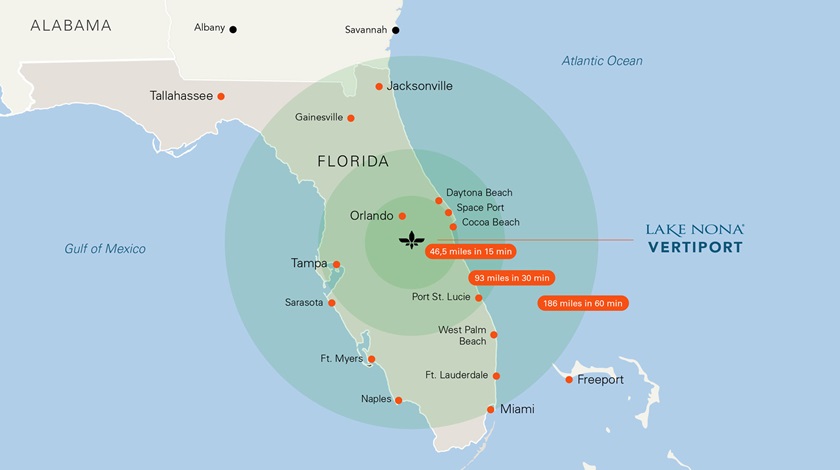Florida fosters flock of future flyers
Lilium lands tax credits to help build Orlando 'vertiport'
A German company working to certify an electric vertical takeoff and landing aircraft with five seats announced on November 11 its partnership with a real estate developer and the city of Orlando, Florida, to build a hub dubbed a “vertiport” about three miles from Orlando International Airport.
The partnership between Lilium, which hopes to certify its battery-powered Lilium Jet in Europe and the United States by 2025, Tavistock Development Co., and the city of Orlando, Florida, was announced November 11, billed to be the first urban and regional air mobility hub in the United States. The “vertiport” stands to be added to the growing mix of amenities in Lake Nona, a 17-acre planned community located just southeast of Orlando International Airport. The infrastructure upgrade remains subject to FAA approval, as does the aircraft Lilium hopes to dispatch to destinations around the city, and beyond.
“For this new technology to truly reshape the transportation ecosystem and benefit Orlando residents long-term, it is going to take a true partnership between cities, developers and transportation operators,” Dyer said in a news release. “We have been focused on finding the right partners to be a global leader in the advanced air mobility space. I’m thrilled that our progressive and collaborative environment has created an opportunity for this unique partnership between the City of Orlando, Lilium and Lake Nona to invest in the expansion of safe, efficient and environmentally friendly transportation options throughout one of the fastest-growing regions in the country.”
Lilium envisions Lake Nona anchoring a regional network that could put Tampa, Daytona Beach, and Port St. Lucie within a 30-minute flight for an aircraft propelled by articulating ducted fans nestled in airfoils; Miami falls just at the projected edge of the new aircraft’s planned flight envelope. The central Florida location puts 20 million state residents within the Lilium Jet’s expected 186-mile range circle, Lilium noted, and the “Lake Nona vertiport will create more than 100 jobs in the Orlando area, with hundreds more to follow across Florida.”
Lake Nona is also home to BBA Aviation/Signature Flight Support and SimCom Aviation Training, which is building a new global headquarters expected to train about 10,000 pilots a year. Significantly, the “Lilium Jet and its operations are designed to comply with existing regulations, policies, and procedures of the relevant aviation rulebooks,” the company noted in a recent certification progress report.
Local officials extended more than their arms in welcome: The New York Times reported that the city council voted November 9 to approve up to $800,000 in potential tax rebates to Lilium, which is based in Munich, Germany.
Lilium is working with the FAA to certify the Lilium Jet under FAR Part 23, hoping to take advantage of recent and future amendments that provide some flexibility for electric propulsion. The new aircraft will be flown by human pilots holding commercial certificates.
“During the training process, Lilium plans to utilize, to the greatest extent possible, new virtual and mixed reality technologies in order to provide a more realistic training experience for the pilots. Doing so will allow pilots to experience both normal and abnormal procedures in a safe and enhanced environment,” Lilium said in October, noting that automation may affect pilot certification requirements down the road: “A future, more simplified pilot license which takes into consideration the high degree of automation of the aircraft and the full range of its capabilities will ideally be developed and utilized to train air crew to operate the Lilium Jet and other eVTOL designs. Lilium is pursuing a path to partner with one of the biggest aviation training organizations, opening up work opportunities for pilots where one day they can choose to pursue a more regional aviation career that would allow them to come home every night.”
In Germany, Lilium is also working with airport authorities in Dusseldorf and Cologne/Bonn to “explore how the two airports can become hubs within a regional air mobility network.”
If Lilium's eVTOL and the fast-growing flock of flying cars all come to fruition, George Jetson might have a second flying car in the garage once Elroy is old enough to drive—and fly.






